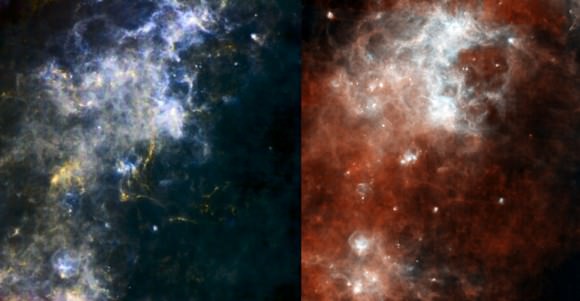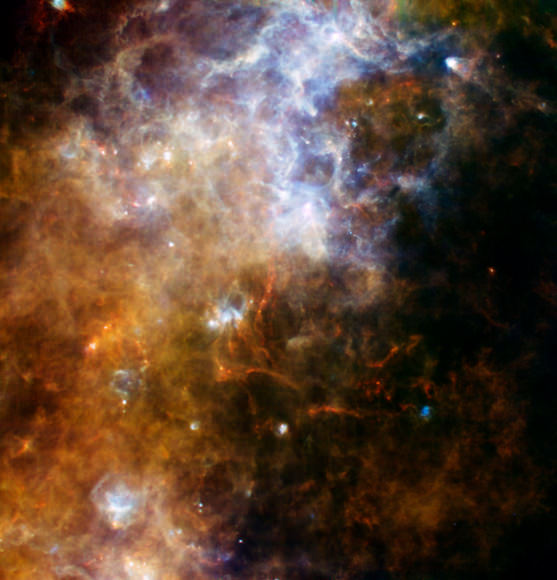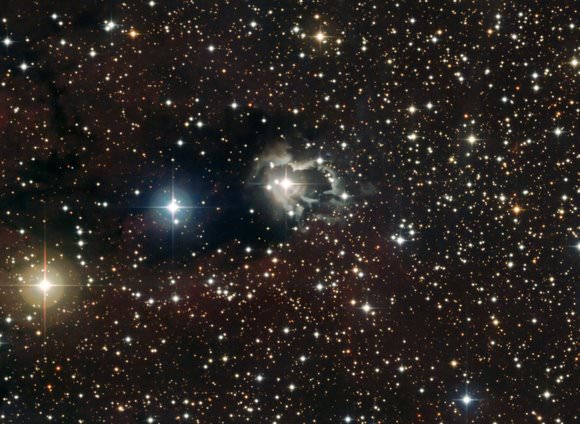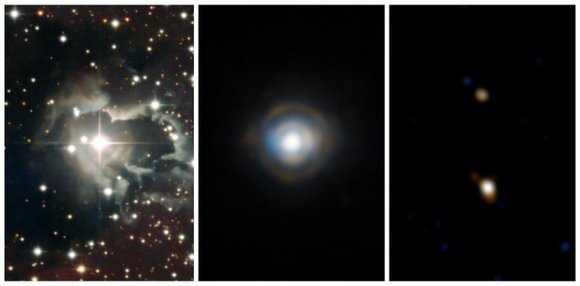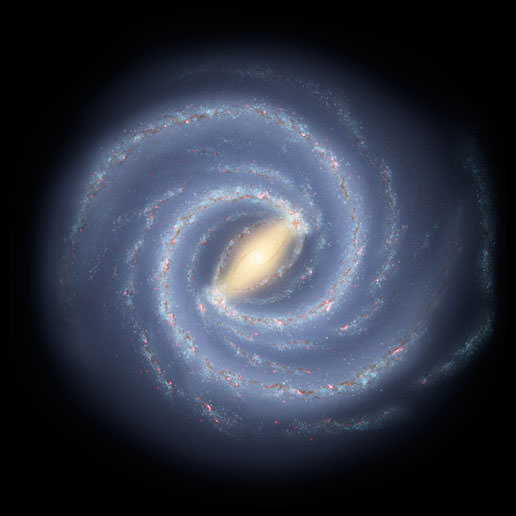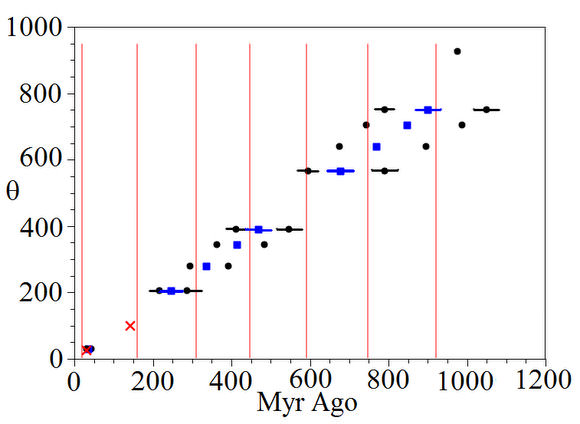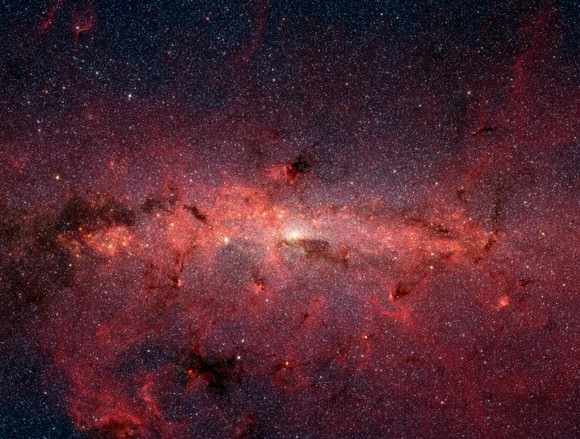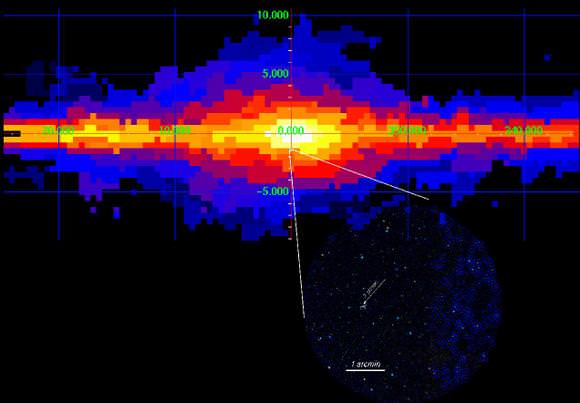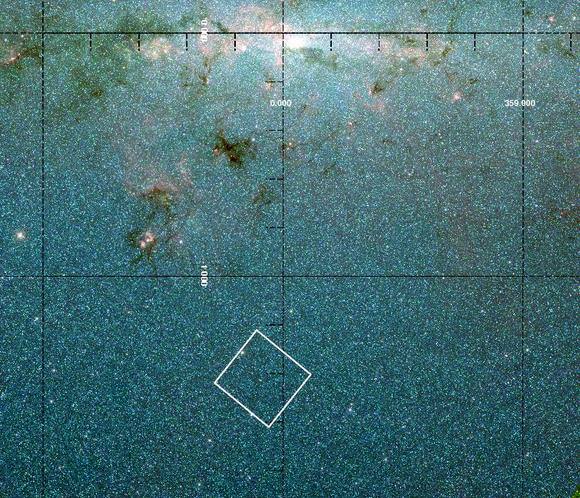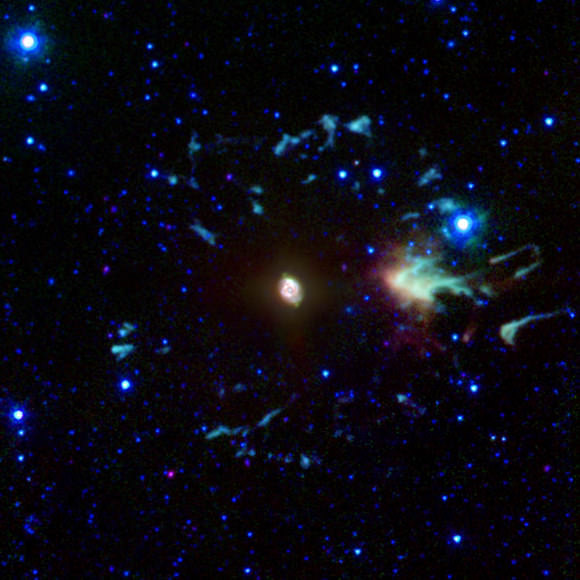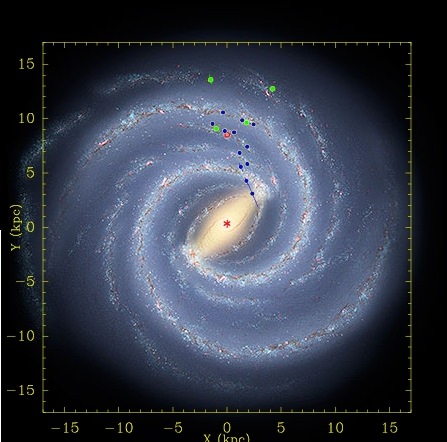[/caption]
For many of us, looking closely in the mirror and stepping on the bathroom scale just after the holidays can reveal a substantial surprise. Likewise, astronomers looking closely at the Milky Way have found our galaxy is more massive than previously thought. High-precision measurements of the Milky Way disclose our galaxy is rotating about 100,000 miles per hour faster than previously understood. That increase in speed, said Mark Reid of the Harvard-Smithsonian Center for Astrophysics, increases the Milky Way’s mass by 50 percent. The larger mass, in turn, means a greater gravitational pull that increases the likelihood of collisions with the Andromeda galaxy or smaller nearby galaxies. So even though we’re faster, we’re also heavier and more likely to be annihilated. Bummer!
The scientists are using the National Science Foundation’s Very Long Baseline Array (VLBA) radio telescope to remake the map of the Milky Way. Taking advantage of the VLBA’s unparalleled ability to make extremely detailed images, the team is conducting a long-term program to measure distances and motions in our Galaxy. At the American Astronomical Society’s meeting in Long Beach, California, Reid said they are using trigonometric parallax to make the measurements. “This is exactly what surveyors use on Earth to measure distances,” he said. “And this is gold standard of measurement in astronomy.”
Trigonometric parallax was first used in 1838 to measure the first stellar distance. However, with better technology, the accuracy is now about 10,000 times greater.
Our solar system is about 28,000 light-years from the Milky Way’s center. At that distance, the new observations indicate, we’re moving at about 600,000 miles per hour in our Galactic orbit, up from the previous estimate of 500,000 miles per hour.
The scientists observed 19 regions of prolific star formation across the Galaxy. In areas within these regions, gas molecules are strengthening naturally-occurring radio emission in the same way that lasers strengthen light beams. These areas, called cosmic masers, serve as bright landmarks for the sharp radio vision of the VLBA. By observing these regions repeatedly at times when the Earth is at opposite sides of its orbit around the Sun, the astronomers can measure the slight apparent shift of the object’s position against the background of more distant objects.
The astronomers found that their direct distance measurements differed from earlier, indirect measurements, sometimes by as much as a factor of two. The star-forming regions harboring the cosmic masers “define the spiral arms of the Galaxy,” Reid explained. Measuring the distances to these regions thus provides a yardstick for mapping the Galaxy’s spiral structure.
The star forming regions are shown in the green and blue dots on the image above. Our sun (and us!) are where the red circle is located.
The VLBA can fix positions in the sky so accurately that the actual motion of the objects can be detected as they orbit the Milky Way’s center. Adding in measurements of motion along the line of sight, determined from shifts in the frequency of the masers’ radio emission, the astronomers are able to determine the full 3-dimensional motions of the star-forming regions. Using this information, Reid reported that “most star-forming regions do not follow a circular path as they orbit the Galaxy; instead we find them moving more slowly than other regions and on elliptical, not circular, orbits.”
The researchers attribute this to what they call spiral density-wave shocks, which can take gas in a circular orbit, compress it to form stars, and cause it to go into a new, elliptical orbit. This, they explained, helps to reinforce the spiral structure.
Reid and his colleagues found other surprises, too. Measuring the distances to multiple regions in a single spiral arm allowed them to calculate the angle of the arm. “These measurements,” Reid said, “indicate that our Galaxy probably has four, not two, spiral arms of gas and dust that are forming stars.” Recent surveys by NASA’s Spitzer Space Telescope suggest that older stars reside mostly in two spiral arms, raising a question of why the older stars don’t appear in all the arms. Answering that question, the astronomers say, will require more measurements and a deeper understanding of how the Galaxy works.
So, now that we know we’re more massive, how do we compare with other galaxies in our neighborhood? “In our local group of galaxies, Andromeda was thought to be the dominant big sister,” said Reid at the conference, “but we’re basically equal in size and mass. We’re not identical twins, but more like fraternal twins. And its likely the two galaxies will collide sooner than we thought, but it depends on a measurement of the sideways motion, which hasn’t been done yet.”
The VLBA is a system of 10 radio-telescope antennas stretching from Hawaii to New England and the Caribbean. It has the best resolving power, of any astronomical tool in the world. The VLBA can routinely produce images hundreds of times more detailed than those produced by the Hubble Space Telescope. The VLBA’s tremendous resolving power, equal to being able to read a newspaper in Los Angeles from the distance of New York, is what permits the astronomers to make precise distance determinations.
Source: AAS, Harvard-Smithsonian Center for Astrophysics
